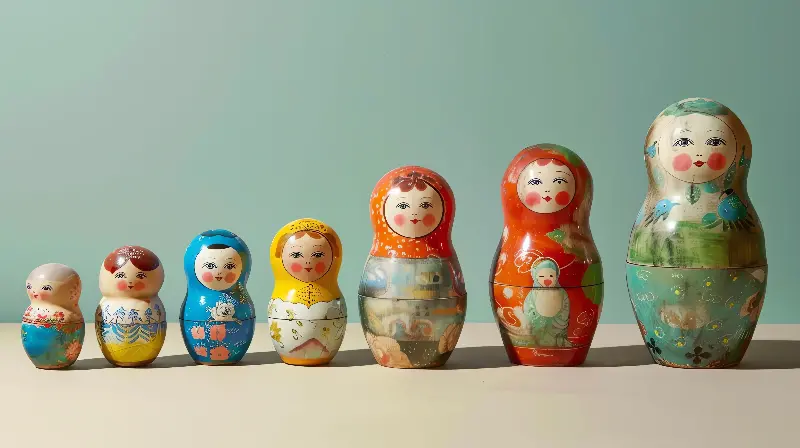
For more than a century, the Russian matryoshka nesting doll has been an iconic symbol of Russian culture—a collection of wooden figures, each one delicately placed inside another, revealing layer upon layer of artistry and mystery. But behind their cheerful painted faces and cheerful folk costumes lies a world of surprising stories and meaningful symbolism that goes far beyond the surface. If you’ve ever wondered who invented these captivating dolls or what stories they carry under their wooden shells, read on for a fascinating look at the history and hidden depths of the matryoshka.
Origins: Not Entirely Russian After All
While the matryoshka is often touted as a quintessentially Russian creation, its origin story has a few unexpected twists. The first-ever Russian matryoshka was designed in 1890 by a Moscow-based folk artist named Sergei Malyutin, in collaboration with woodturner Vasily Zvyozdochkin. But their inspiration didn’t come from Russian folklore alone. Instead, they borrowed the idea from Japanese nesting dolls representing the Seven Lucky Gods, called “Fukuruma.”
What set the Russian version apart was its style and cultural references—Malyutin’s vision brought the nesting doll into Russian tradition by painting the outer figure as a plump peasant woman in a sarafan, a traditional Russian dress, often holding a rooster or flowers. Inside, each subsequent doll represented other members of a peasant family, from daughters and sons to the tiniest baby at the core. Thus, the Russian matryoshka was born from a blend of global artistic influences, forever linking Russian craft to a wider world of creativity.
More Than a Toy: The Symbolism Behind Each Doll
Though they might appear to be charming playthings, matryoshkas are rich with layers of symbolism. The very structure of the doll—smaller dolls hidden within larger ones—evokes ideas of motherhood, family, fertility, and generational continuity. The word "matryoshka" itself is derived from "Matryona," a popular female name among Russian peasants at the time, closely associated with the essence of motherliness and nurturing.
In Russian culture, the matryoshka is seen as a symbol of unity and wholeness. Each doll fits snugly into the next, just as family members are embedded within each other’s lives. In some interpretations, the largest, outermost doll represents the mother or the head of the family, while each smaller one nestled inside can represent children or subsequent generations. This concept is sometimes extended to a broader metaphor for the Russian soul—layered, mysterious, and full of surprises beneath each surface.

Evolving Artistry: Beyond Traditional Designs
If you think all matryoshka dolls look the same, think again. Throughout the decades, artists have expanded far beyond the rural mother motif. Soviet-era matryoshkas famously featured not just peasants, but politicians—Stalin, Lenin, and other leaders—even satirical representations that poked gentle fun at famous personalities. In contemporary workshops, you can now find dolls painted to depict fairy tale characters, historical figures, movie stars, and athletes.
Each region of Russia also developed its own distinctive style. Sergiev Posad, the birthplace of matryoshkas, is known for its vibrant folk patterns. Semionovo matryoshkas are instantly recognizable by their red outer garments and yellow floral decorations. Nowadays, some artists even blend the tradition with abstract art, or use the nested form to tell stories about social issues, feminism, or environmentalism. The only thing they have in common is that sense of storytelling through layers.
Matryoshkas as Messengers: Politics, Satire, and Protest
Surprisingly, matryoshka dolls have sometimes been wielded as unexpected artistic and political tools. In the post-Soviet era, artists began to play with the format to make pointed social commentary. A famous example featured a nesting set starting with the outermost figure painted as Stalin, then successively revealing Lenin, Marx, and ultimately ending with a tiny tsar inside—a sly nod to the cyclical nature of Russian power.
Political matryoshkas have been given as diplomatic gifts—President Bill Clinton reportedly received a set featuring his own likeness, layered with caricatures of American presidents past. Other artists have used matryoshkas to satirize celebrity culture or to critique global events, demonstrating how these humble toys can bear the weight of national and personal identity.
Global Ambassadors: How Matryoshkas Won the World
Despite their deeply Russian roots, matryoshka dolls quickly became world travelers. The first Russian matryoshka received a bronze medal at the Paris World’s Fair in 1900, sparking international fascination. Since then, they’ve become favorite souvenirs for tourists from every country, gracing shelves from Tokyo to Buenos Aires, and inspiring creative interpretations in countless cultures.
Today, the matryoshka continues to serve as a symbol that bridges past and present, tradition and innovation. For many Russians and admirers around the globe, these dolls are a comforting reminder of unity and heritage—while also offering a playful invitation to discover what might be hidden just beneath the surface.
Whether you appreciate matryoshka dolls for their artistry, their symbolism, or simply their cheerful presence, there’s always more to them than meets the eye. Next time you pick up a nesting doll and open its wooden heart, remember: each layer has a story to tell, and sometimes, the smallest voice at the center holds the greatest surprise.
